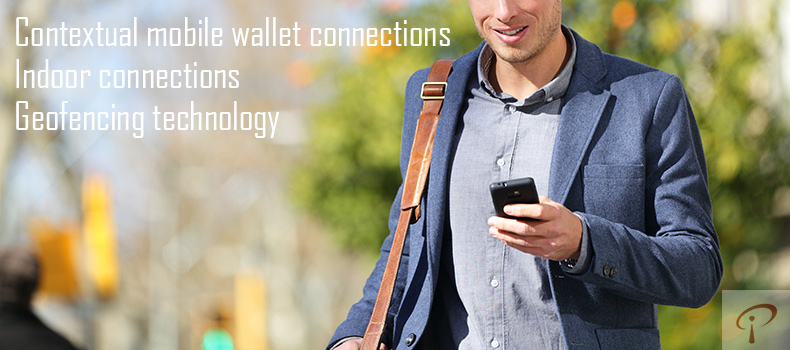Sep
18
Wireless technologies and types of mobile wallet connections

In this series on mobile wallets, so far I have covered:
- The definition of a mobile wallet
- Proximity mobile wallets and remote mobile wallets
- Umbrella and integrated wallets
- Mobile wallet services and functions
- The deployment of mobile wallet services for a user
- Mobile wallet analytics and personalization
Wireless technologies are another key feature and enabler for mobile wallets. Wireless technologies connect the involved parties like the user and local businesses; they enable data exchange and the principles of “capture” and “execute” in the big data and analytics context. Generally, three types of mobile wallet connections and interactions can be distinguished for wireless technologies: contextual, indoor and geofencing.
Contextual mobile wallet connections
In contextual connections, the user (or other involved entities) connects in a specific context or initiates a specific action using his or her mobile wallet. That means a context-specific information exchange has already happened, and the user has agreed by initiating it. Typical technologies for this are QR codes or near field communication (NFC).
By showing or reading a QR code, the user shows his interest in the information content or the action linked to this QR code (for example, downloading a coupon or opening a website). When touching a contactless payment acceptance terminal with an NFC phone, the user intentionally agrees to initiate the specific payment interaction, and no further confirmation is required. As this category of interaction provides a lot of insights about what users are interested in, and what they want to do, it is also highly relevant for mobile wallet analytics and, hence, data capture.
Indoor connections
The indoor category of mobile wallet connections allows interaction within a medium distance area, like in a shop or a room. In most cases, it also allows position tracking within the range of interaction. The data captured can provide insights about what the user is interested in. For example, heat maps can be built to indicate which areas in a shop are visited by most users and for the longest time. Also, users can be identified by local businesses and directed by their phones to specific areas.
The information shared using indoor connections, however, is broader and not as accurate and specific as in the contextual category. Also, specific actions, like a payment transaction, require an additional step of interaction for initiation and confirmation. Indoor connections are therefore not as intuitive and immediate as contextual connections.
The technologies used for indoor connections are WLAN/WiFi and Bluetooth low energy (BLE). For both types, one of the major challenges is check-in by the users, since this potentially also requires user confirmation, though for BLE the barriers have been significantly lowered. The indoor category is relevant for data capture and also for executing personalized offerings and customer interaction.
Geofencing technology
The data granularity, user tracking and information in the geofencing area are even broader and more general because geofencing technology is used outside of the local business. Interaction with the user is relevant for attracting and guiding users to the local business. Little product-specific information can be generated through geofencing.
Check-in is not an issue, as the user has typically installed an app and checked in for geofencing. For actions and confirmations, even less context is given, and potentially more steps and information are required to initiate any form of transaction. The technologies used in geofencing are mainly the mobile network and GPS.

The different ways of interaction between wallet parties
The three categories of wireless technologies are all relevant for mobile wallets and the customer journey. However, the applications and usage scenarios differ, and each category of mobile wallet connections has certain advantages and disadvantages. This is also true for the technologies within each category. The broader the coverage of wireless technology in a mobile wallet, the broader the application scenarios. And none of the categories can fully offset the need for the others.
Now that we’ve covered the different user scenarios and possibilities for mobile wallets, how do you know which type of mobile wallet to use? In the next post of my mobile wallet series, I’ll address when to use a proximity versus a remote wallet.


















































